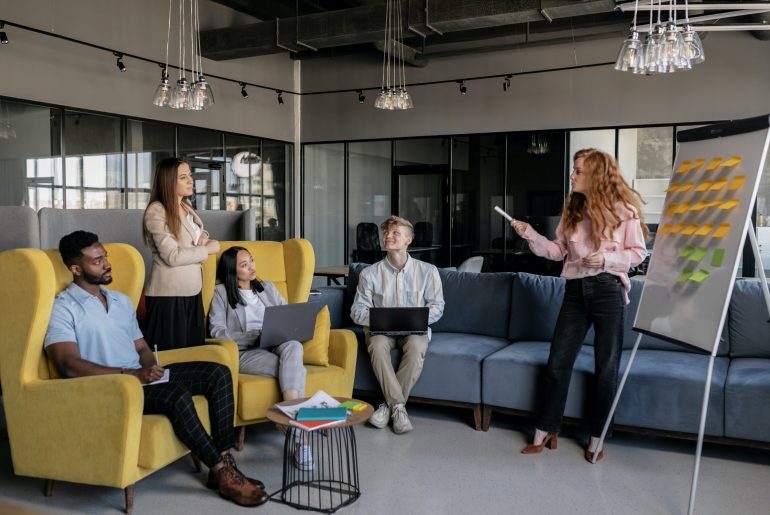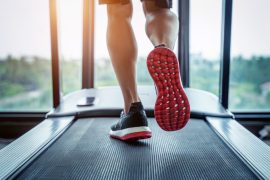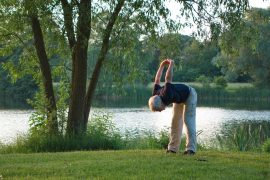 One of the key components of the BeUpstanding program is to hold a staff consultation workshop with all team members. The aim of the workshop is to provide information about the program to staff, give them the opportunity to discuss potential ways in which they can stand up, sit less, and move more at work, and the collectively select three top strategies to implement as a team during the 8-week program and beyond. Ideally the workshop is held in-person, however, we know that COVID and other factors have affected how and where people work. As a result, an in-person staff workshop was not always possible for the teams taking part in our national trial of BeUpstanding and teams conducted this consultation and gained staff input in various ways.
One of the key components of the BeUpstanding program is to hold a staff consultation workshop with all team members. The aim of the workshop is to provide information about the program to staff, give them the opportunity to discuss potential ways in which they can stand up, sit less, and move more at work, and the collectively select three top strategies to implement as a team during the 8-week program and beyond. Ideally the workshop is held in-person, however, we know that COVID and other factors have affected how and where people work. As a result, an in-person staff workshop was not always possible for the teams taking part in our national trial of BeUpstanding and teams conducted this consultation and gained staff input in various ways.
As part of our research, we are interested in finding out how staff were engaged in decision making around potential BeUpstanding strategies. This data was obtained via the program completion survey that workplace BeUpstanding champions completed upon finishing the 8-week implementation phase of the program. In the survey, champions were asked how they gained input from staff on how they wanted to BeUpstanding (in addition to or instead of the staff workshop), as well as how they chose between all the suggestions that were provided by their work team as to which would be the top three strategies to stand up, sit less and move more.
Aside from the staff workshop, other common ways champions reported that staff input was gained included:
- Discussions at regular staff meetings
- Emailing staff asking for input
- Microsoft Teams discussion boards
- Physical suggestion board / feedback box in the office
- General in-person conversations with staff in the team
For teams with more remote working arrangements, virtual ideas boards / chats (using Microsoft Teams, Zeetings, Webex), emails to staff, and the utilisation of online tools such as Google forms were ways in which input was gained from staff.
 When it came to selecting the final strategies for teams to sit less and move more in the program, champions reported a variety of methods. One of the most common ways was voting by staff on suggested strategies and going with the majority vote. The method of voting varied from a show of hands in the staff workshop or meeting, group voting with post-it notes for the most popular options, using a virtual ideas board to select the top 3, to staff voting via an online survey using tools such as Google forms or Survey Monkey that were sent out to staff by the champion. These methods and others can be seen in the following selection of champion responses:
When it came to selecting the final strategies for teams to sit less and move more in the program, champions reported a variety of methods. One of the most common ways was voting by staff on suggested strategies and going with the majority vote. The method of voting varied from a show of hands in the staff workshop or meeting, group voting with post-it notes for the most popular options, using a virtual ideas board to select the top 3, to staff voting via an online survey using tools such as Google forms or Survey Monkey that were sent out to staff by the champion. These methods and others can be seen in the following selection of champion responses:
“Suggestions made and implemented were the most cost effective and had the ability to be implemented straight away. [We] discussed in [the] meeting/workshop and voted/decided together.”
“We asked the team to rank their preferred strategies and then held a discussion to confirm which would be our top three. The ranking was fairly unanimous, and a group decision was made to confirm.”
“We did a country-wide presentation at the same time with different presenters for the staff workshop. We then used a google form survey to gather ideas and input and then manipulate this to form our initiatives.”
Feasibility of implementing the strategies was a key consideration mentioned by champions when it came to deciding on the top three strategies, as noted in the following champion responses:
“[The] BeUpstanding Team (Champion and 2 other staff members) looked at [the] results from [the] office audit and staff survey [and chose the] results with [the] highest feasibility.”
“The eventual strategies that each team would adopt were determined through some collective decision making by each team. Feasibility was a key consideration.”
“We brainstormed all ideas, then asked the team to vote. Top 3 votes were our formal strategies, however we also incorporated a number of the other ideas. We talked through feasibility (e.g., budget for equipment, time spent doing activities etc) but the final vote came down to what we thought was manageable and achievable.”
“[We held] staff consultation via the initial workshop, and the team chose their strategies based on feasibility and practicality given the team is separated into two sites.”
 In many workplaces, staff provided input on suggestions for the strategies. However, the champion reported that the final decision was made by themselves, by a committee like OH&S or the BeUpstanding well-being committee, or senior management as highlighted by a selection of our champion responses below:
In many workplaces, staff provided input on suggestions for the strategies. However, the champion reported that the final decision was made by themselves, by a committee like OH&S or the BeUpstanding well-being committee, or senior management as highlighted by a selection of our champion responses below:
“I chose according to the existing resources and work duties.”
“It was a little difficult to reach consensus during our short staff workshop. We identified general ‘themes’ to address then refined these later in a 5-member BeUpstanding committee.”
“Management needed final say on top 3 – The strategies were voted upon, but there were strategies that could not be accommodated for OHS reasons or budget considerations. The top strategies that were feasible, as voted by the staff, were used. This was then approved by management before announcing and implementing.”
“We allowed the champion to choose the strategies for their location. Most were based on popularity.”
“Staff voted on their top 3 using the virtual idea boards, I then made the call as the champion based on the votes and grouping like strategies. I did run these by my Exec Manager and Director for confirmation before agreeing and communicating these with the broader team.”
In teams where staff were working from home or in a hybrid work model, the decision often came down to selecting what was practical in terms of being able to implement while working from home, as highlighted in this champions response:
“The easiest ones for when working from home.”
One of the unique things about the BeUpstanding program is its ability to be tailored to any working environment no matter the size of the organisation or team. We know that a one size fits all approach doesn’t always work when it comes to creating long term change within a workplace as every workplace is different. Gaining staff input and buy-in for change is a key factor in determining the success a wellbeing program and as seen above, there are many ways that this can be done successfully.
![]()










Comments are closed.